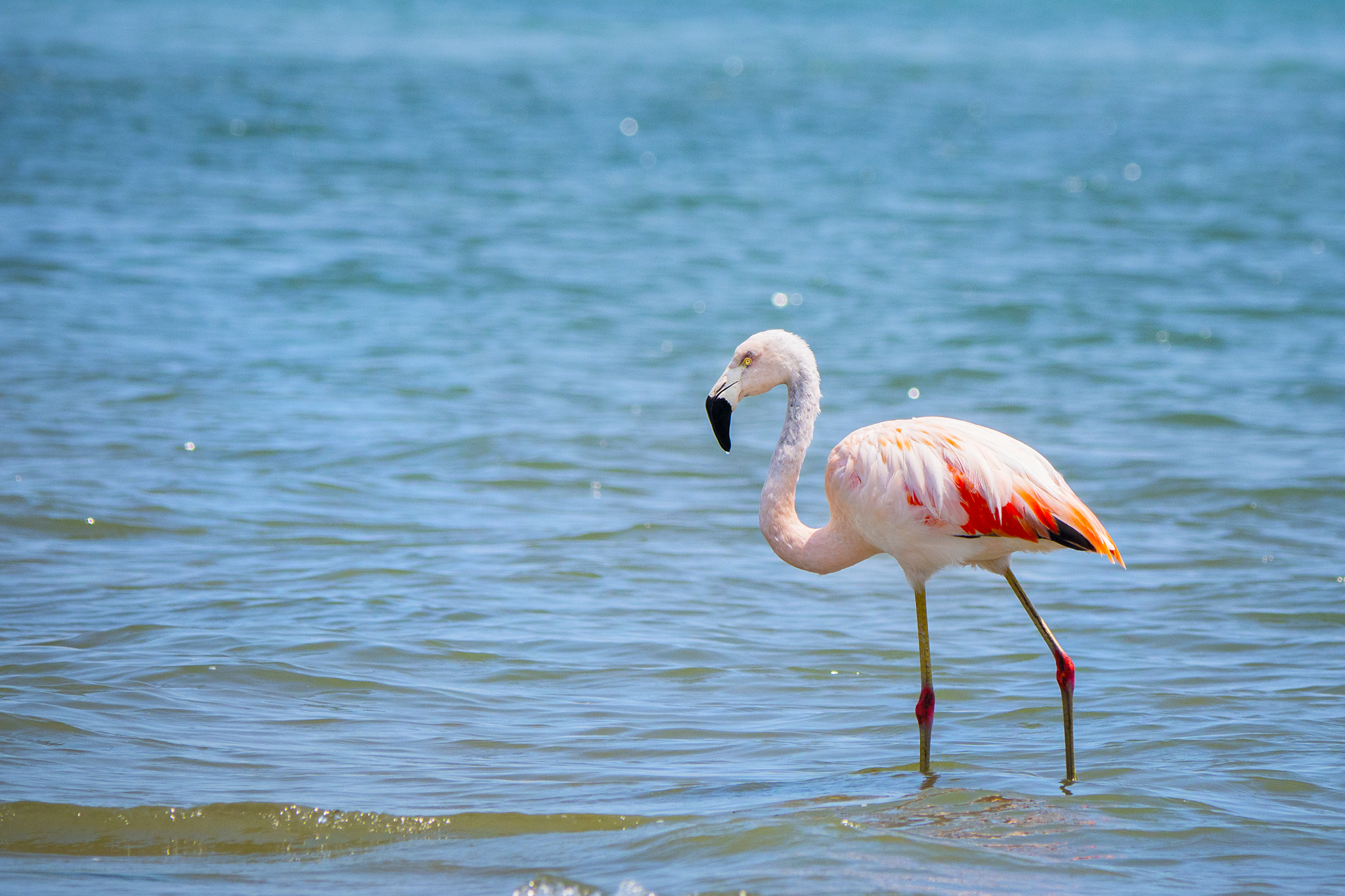Flamingos are one of the most iconic birds on the planet, and Paracas is home to a healthy population of Chilean Flamingos. As I was researching this series, I came to realise that what makes flamingos so unique is, without a doubt, their anatomy. I’m not entirely convinced that these birds aren’t aliens, or the result of some strange science experiment. The more I read, the stranger these birds became. So let’s get into it!

Chilean Flamingos can be distinguished from the other four species of flamingo in the Americas by their knees. Chilean Flamingos, unlike any other species, have bright pink knees… Okay, that’s not entirely true. They actually have bright pink ANKLES.
Flamingo knees are entirely hidden from view, tucked away under their feathers. The joint you see in the middle of its leg is in fact the ankle, and everything below that is technically part of its foot. That’s why flamingo legs appear to bend the wrong way while they’re walking. In reality, they’re just constantly walking on their tip-toes and bending their ankle joint in order to stroll around.
If you reckon that’s weird. We’re just getting started…

Flamingos are ‘filter-feeders’, meaning that they eat by passing water through their beaks and straining out the tasty stuff. Hilariously, they do this by turning their heads upside down and then trailing their beaks through the water. Whilst this is occurring, the flamingo’s tongue is used as a kind of pump to continuously push more water through its beak. (Side note: Flamingo tongues were regarded as a delicacy in Ancient Rome.)
As if all this wasn’t weird enough, a 2006 study showed that flamingos also have erectile tissue located at the base of their mouths, on either side of the tongue. As you’re probably aware, erectile tissue hardens when blood flows to it (get your mind out of the gutter, this is hard science 👀). So basically, when a flamingo turns its head upside-down in order to feed, the blood rushes to its head, and its mouth hardens. It’s hypothesised that this gives the flamingo greater stabilisation while feeding. Sounds legit – I’ve never tried eating with my head upside down but I imagine balance would be an issue.
Flamingos typically eat algae and shrimp, but a curious aspect of their diet adds credence to the old cliché, ‘you are what you eat’…

But before we get into flamingo diet facts, I have a question for you.
What is a flamingo’s natural colour?
Take your time. You can even have a look at the flamingo in the picture if you’re not entirely sure.
Got an answer locked in? Okay, great.
If you answered pink, or red, or pinkish-reddish, or any kind of combination of pink or red – you are absolutely, 100% wrong. (Sorry)
Fascinatingly, a flamingo’s pink colouration is actually the result of beta-carotene, a red-orange pigment that is found in large amounts in the algae and shrimp that flamingos eat. A flamingo’s natural colour is therefore completely white, and their pink colour is purely the result of their diet. The more healthy and well-fed a flamingo is, the brighter pink it will turn, and consequently, the pinkest flamingos tend to be the ones most likely to successfully find a mate.
As mentioned, beta-carotene is a red-orange pigment, and while flamingo food tends to be on the red end of the spectrum, a family-favourite vegetable sits at the orange end. Beta-carotene is found in high concentrations in carrots, which is where they get both their name, and their distinctive orange colour. In fact, it is entirely possible for a human to turn orange from excessive carrot consumption in the same way a flamingo turns pink. If you ate around ten carrots a day for a period of several weeks, you would begin to see a noticeable orange tinge to your skin. It’s perfectly harmless and even has an official medical name – carotenemia.
I wonder if perhaps Donald Trump just really likes carrots?

Flamingos have some of the longest lifespans in the avian world. They are known to live up to 40 years of age in the wild, but can survive much longer in captivity. The world’s oldest flamingo died at Adelaide Zoo in 2014, at the ripe old age of 83. (Interestingly, Adelaide Zoo was also home to the world’s oldest sloth until it passed away in 2017 – must be something in the water!)
With such long lives, it’s no surprise that flamingo colonies usually number in the thousands, with one group in East Africa estimated at a whopping two million! They’re also excellent flyers, and are known to travel extraordinary distances.
In 2005, an African Flamingo known as Pink Floyd escaped from a zoo in Kansas, and has been on the run for the 17 years since. The most recent sighting of the fugitive was about a month ago in Texas, but he has also been spotted as far north as Wisconsin – more than 2,000km from his current position.
Flamingos are highly social creatures, and often form a variety of important bonds – from monogamous mating pairs, to long-term friendships, and even same-sex parenting. In 2006, Pink Floyd made friends with a lone Caribbean Flamingo, believed to have accidentally arrived in Texas on the back of a tropical storm. The two remained in each other’s company for more than seven years, and Floyd has also been recorded hanging out with flocks of birds from other species in order to satiate his desire for friendship!
Flamingos are anatomically strange, artificially coloured, amazingly loyal birds, with intricate and variable social networks. I hope you’ve enjoyed learning about them as much as I have!
–
Chilean Flamingos (Phoenicopterus chilensis), Paracas, Peru


